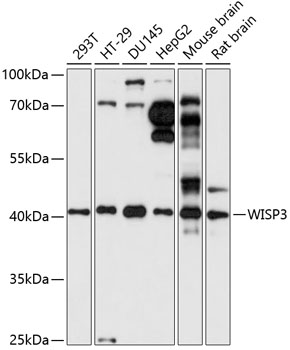Anti-WISP3 Antibody (CAB14812)
- SKU:
- CAB14812
- Product type:
- Antibody
- Reactivity:
- Human
- Reactivity:
- Mouse
- Reactivity:
- Rat
- Host Species:
- Rabbit
- Isotype:
- IgG
- Antibody Type:
- Polyclonal Antibody
- Research Area:
- Immunology
Frequently bought together:
Description
| 抗体名: | Anti-WISP3 Antibody |
| 抗体コード: | CAB14812 |
| 抗体サイズ: | 20uL, 50uL, 100uL |
| 申し込み: | WB |
| 反応性: | Human, Mouse, Rat |
| 宿主種: | Rabbit |
| 免疫原: | Recombinant fusion protein containing a sequence corresponding to amino acids 42-260 of human WISP3 (NP_937882.1). |
| 申し込み: | WB |
| 推奨希釈: | WB 1:500 - 1:2000 |
| 反応性: | Human, Mouse, Rat |
| ポジティブサンプル: | 293T, HT-29, DU145, HepG2, Mouse brain, Rat brain |
| 免疫原: | Recombinant fusion protein containing a sequence corresponding to amino acids 42-260 of human WISP3 (NP_937882.1). |
| 精製方法: | Affinity purification |
| ストレージバッファ: | Store at -20'C. Avoid freeze / thaw cycles. Buffer: PBS with 0.02% sodium azide, 50% glycerol, pH7.3. |
| アイソタイプ: | IgG |
| 順序: | TGPL DTTP EGRP GEVS DAPQ RKQF CHWP CKCP QQKP RCPP GVSL VRDG CGCC KICA KQPG EICN EADL CDPH KGLY CDYS VDRP RYET GVCA YLVA VGCE FNQV HYHN GQVF QPNP LFSC LCVS GAIG CTPL FIPK LAGS HCSG AKGG KKSD QSNC SLEP LLQQ LSTS YKTM PAYR NLPL IWKK KCLV QATK WTPC SRTC GMGI SNRV TNEN SNCE MRK |
| 遺伝子ID: | 8838 |
| Uniprot: | O95389 |
| セルラーロケーション: | Secreted |
| 計算された分子量: | 39kDa/41kDa |
| 観察された分子量: | 41kDa |
| 同義語: | WISP3, CCN6, LIBC, PPAC, PPD, WISP-3 |
| バックグラウンド: | This gene encodes a member of the WNT1 inducible signaling pathway (WISP) protein subfamily, which belongs to the connective tissue growth factor (CTGF) family. WNT1 is a member of a family of cysteine-rich, glycosylated signaling proteins that mediate diverse developmental processes. The CTGF family members are characterized by four conserved cysteine-rich domains: insulin-like growth factor-binding domain, von Willebrand factor type C module, thrombospondin domain and C-terminal cystine knot-like domain. This gene is overexpressed in colon tumors. It may be downstream in the WNT1 signaling pathway that is relevant to malignant transformation. Mutations of this gene are associated with progressive pseudorheumatoid dysplasia, an autosomal recessive skeletal disorder, indicating that the gene is essential for normal postnatal skeletal growth and cartilage homeostasis. Multiple transcript variants encoding different isoforms have been found for this gene. |
| UniProt Protein Function: | WISP3: Appears to be required for normal postnatal skeletal growth and cartilage homeostasis. Defects in WISP3 are the cause of progressive pseudorheumatoid arthropathy of childhood (PPAC). PPAC is an autosomal recessive disorder characterized by stiffness and swelling of joints, motor weakness and joint contractures. Signs and symptoms of the disease develop typically between three and eight years of age. This progressive disease is a primary disorder of articular cartilage with continued cartilage loss and destructive bone changes with aging. Belongs to the CCN family. 2 isoforms of the human protein are produced by alternative splicing. |
| UniProt Protein Details: | Protein type:Secreted; Cell cycle regulation; Secreted, signal peptide Chromosomal Location of Human Ortholog: 6q21 Cellular Component: proteinaceous extracellular matrix Molecular Function:heparin binding; integrin binding Biological Process: cell adhesion; cell-cell signaling; signal transduction Disease: Arthropathy, Progressive Pseudorheumatoid, Of Childhood |
| NCBI Summary: | This gene encodes a member of the WNT1 inducible signaling pathway (WISP) protein subfamily, which belongs to the connective tissue growth factor (CTGF) family. WNT1 is a member of a family of cysteine-rich, glycosylated signaling proteins that mediate diverse developmental processes. The CTGF family members are characterized by four conserved cysteine-rich domains: insulin-like growth factor-binding domain, von Willebrand factor type C module, thrombospondin domain and C-terminal cystine knot-like domain. This gene is overexpressed in colon tumors. It may be downstream in the WNT1 signaling pathway that is relevant to malignant transformation. Mutations of this gene are associated with progressive pseudorheumatoid dysplasia, an autosomal recessive skeletal disorder, indicating that the gene is essential for normal postnatal skeletal growth and cartilage homeostasis. Multiple transcript variants encoding different isoforms have been found for this gene. [provided by RefSeq, Jul 2008] |
| UniProt Code: | O95389 |
| NCBI GenInfo Identifier: | 34098394 |
| NCBI Gene ID: | 8838 |
| NCBI Accession: | O95389.1 |
| UniProt Secondary Accession: | O95389,Q3KR29, Q5H8W4, Q6UXH6, |
| UniProt Related Accession: | O95389 |
| Molecular Weight: | 41,402 Da |
| NCBI Full Name: | WNT1-inducible-signaling pathway protein 3 |
| NCBI Synonym Full Names: | WNT1 inducible signaling pathway protein 3 |
| NCBI Official Symbol: | WISP3 |
| NCBI Official Synonym Symbols: | PPD; CCN6; LIBC; PPAC; WISP-3 |
| NCBI Protein Information: | WNT1-inducible-signaling pathway protein 3 |
| UniProt Protein Name: | WNT1-inducible-signaling pathway protein 3 |
| UniProt Synonym Protein Names: | CCN family member 6 |
| Protein Family: | WNT1-inducible-signaling pathway protein |
| UniProt Gene Name: | WISP3 |
| UniProt Entry Name: | WISP3_HUMAN |


